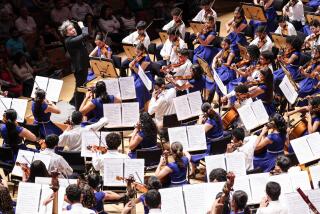Vienna Choir Boysâ Graceful Singing Lives Up to Tradition
Other ensembles come and go, but the Vienna Choir Boys seem to be forever. Now launched on its second half-millennium, the famed choir has visited the U.S. almost annually since 1932, and the 23-boy contingent heard Friday at Marsee Auditorium of the El Camino College Center for the Arts upheld its venerable traditions with joy and diligence.
Organizationally, the path to the future has been an uneven one. In 1996, the Choir Boys appointed its first woman artistic director, Agnes Grossman, and a year later began admitting girls to the Choir School. But two months ago Grossman resigned over differences with the managing board about the addition of a fifth choir to spread the concert load and other matters, a change not yet reflected in the program profile.
Grossman had begun expanding the Choir Boysâ active repertory, something that some of the former choir members who run the organization suggested was more of a problem than the number of performances. The difficult, unaccompanied âStella, quam viderant Magi,â by Jacob Regnart, may be a relic of her influence, sung Friday with some hesitance in the initial entrances but developed with confidence and grace.
That and a striking âEgo sum panis vivusâ by Antonio Caldera were the high points of the opening group of sacred choruses and part-songs. Conducted and accompanied here by Martin Schebesta, these Choir Boys delivered the expected clarity of diction and articulation, sensitive to style and texture.
One traditional element of a Vienna Choir Boys program that is surely ripe for rethinking is the potted operetta. With each season the laughter seems to be more and more at the boys rather than with them, struggling gamely with unflattering costumes.
The secular songs that closed the program featured two lovingly balanced songs by Brahms, and the set climaxed with a group of polkas and waltzes by Johann Strauss Jr. In encore the Choir Boys went vernacular, offering the inevitable âEdelweiss,â an Austrian folk song, âDixieâ and âMaryâs Little Lamb Blues.â
More to Read
The biggest entertainment stories
Get our big stories about Hollywood, film, television, music, arts, culture and more right in your inbox as soon as they publish.
You may occasionally receive promotional content from the Los Angeles Times.










